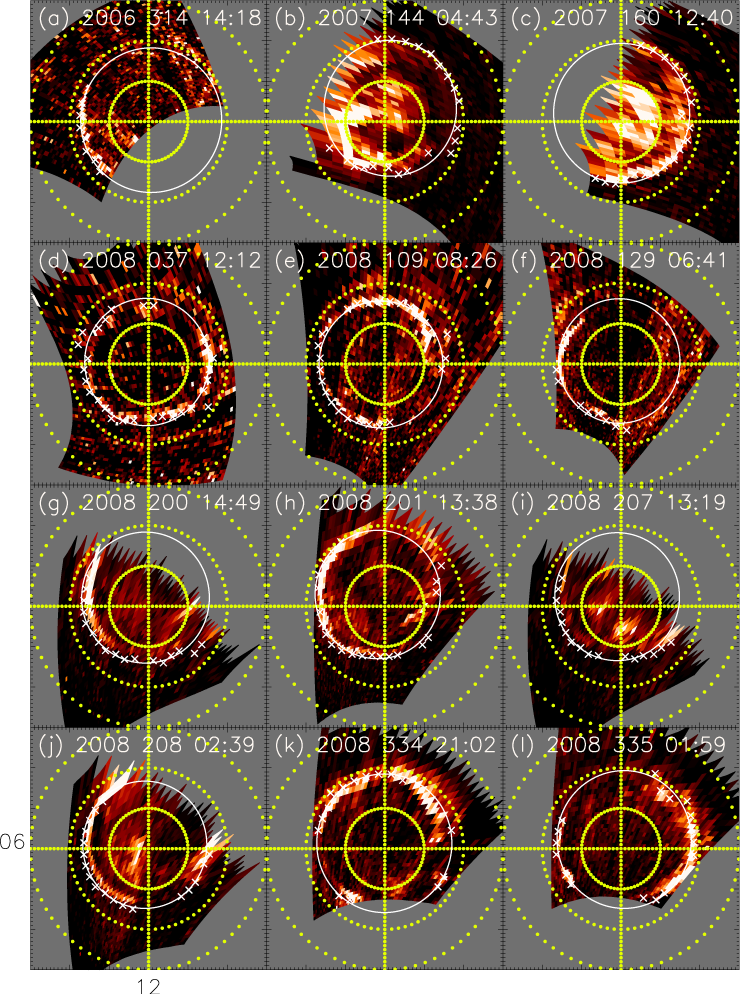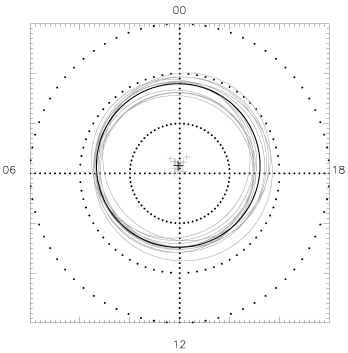New Results@iú{êLÖj
Location of Saturn's northern infrared aurora determined from Cassini VIMS images
Sarah V. Badman / JAXA International Research Fellow
Observations of Saturn's aurora provide a unique means of remote sensing the planet's dynamic magnetosphere. Studies of the southern ultraviolet (UV) emissions e.g. by the Hubble Space Telescope (HST) have revealed that the aurora generally takes the form of an oval of radius ∼15° co-latitude centred roughly on the pole. Nevertheless, the morphology, brightness and location of the aurora are variable and have exhibited dependences on the impinging solar wind and the pulsing of Saturn's kilometric radiation [e.g. Clarke et al., 2005; Nichols et al., 2010].
Upon impacting the upper atmosphere, incident electrons undergo several interactions to generate auroral emissions across a range of wavelengths. The strongest UV emissions are H Lyman-¿ and H2 Lyman- and Werner-band transitions, following excitation by electron impact. To generate IR emissions, however, the electrons ionize atmospheric H2 to form H2+ which then reacts with H2 to produce the H3+ ionized molecule. Ro-vibrational transitions of the H3+ molecule produce the observed IR auroral emissions. The majority of the IR and UV aurora are thought to be emitted from similar altitudes above the homopause, suggesting their basic morphologies could match. However, factors such as the indirect production of H3+ and the temperature dependence of its emissions complicate this initial assumption. For example, Stallard et al. [2008] identified bright polar emissions in VIMS images of the IR aurora and suggested they could be attributed to either a region of raised atmospheric temperature (which would lead to intensified IR but not UV emissions), or to the nature of the magnetospheric field lines and particles mapping to the aurora. It is clear therefore that while the UV and IR aurora are similar in many ways, they also exhibit intriguing differences. The purpose of this study is to characterise one of the fundamental properties of the IR aurora, its location, to help constrain the relationship. This is the first analysis of the location of Saturn's IR aurora, made possible by the Cassini VIMS data set. As Saturn's northern aurora has only recently been visible from the Earth as Saturn passed through equinox, they have not yet been studied in detail. This study therefore focusses on analysis of the northern main oval aurora under winter conditions.
Figure 1. Images of Saturn's northern IR aurora acquired by Cassini VIMS. The images have been polar projected to an altitude of 1000 km above the 1 bar reference spheroid and are orientated with the sunward direction at the bottom, dawn to the left and dusk to the right, labelled on panel (j). The grey-shaded regions are areas outside the VIMS FOV. The yellow grid marks the noon-midnight and dawn-dusk meridians, and latitudes at intervals of 10 degrees. The white crosses and circles mark the boundary points and best fit to the equatorward auroral boundary for each image.
This study employs twelve images of Saturn's northern IR aurora acquired by Cassini VIMS during 2006-2008, shown in Figure 1. Overall, the IR auroral morphologies observed in these images demonstrate variability in both form and location. Bright arcs were commonly observed at all local times as well as diffuse polar emissions. The polar emissions varied from localised spots to large-scale infilling. It is clear that the region poleward of the main oval was more intense in the IR than the lower latitude region. Further analysis is underway to develop understanding of the generation of the polar emissions in relation to the main oval.
Figure 2. Polar view of the best-fit auroral boundary circles for each image (grey) and the average circle (black). The individual and average circle centres are marked by the grey and black crosses, respectively.
To determine the typical extent of the IR aurora, the equatorward boundary of the emission was marked at intervals of 10° longitude, where a sharp boundary could be determined within the FOV. A best fit circle was derived for the boundary points detected for each image. These circles are plotted in white on each panel in Figure 1. The best-fit circles are plotted together on a polar grid by the grey circles in Figure 2. The centres of the circles are also plotted by the grey crosses. Averaging over the derived best fit circles, the mean circle was found to have a radius of 16.4 ± 0.2° with a centre position of 1.6° anti-sunward and 0.3° towards dawn. This average circle and its centre are marked in black on Figure 2. The standard deviation of this radius value is just 0.8°, which demonstrates the relative stability of the equatorward auroral boundary. While the poleward boundary of the aurora has been shown to lie at the boundary between open and closed field lines and thus changes position over a large range of latitudes depending on the solar wind interaction, the equatorward boundary of the aurora maps deeper inside the magnetosphere, close to the outer edge of the ring current region according to the most up-to-date models, and is more stable over time (e.g. Badman et al., 2006). The northern IR auroral oval is typically offset towards midnight by ∼1.6°, probably due to solar wind pressure on the dayside, such that the average equatorward boundary of the aurora is found to lie at ∼15° co-latitude on the dayside.
Nichols et al. [2009] used a similar method of circle-fitting to determine the average equatorward boundary of Saturn's northern UV aurora from HST images taken in early 2009. They found a circle radius of 16.3 ± 0.6°, which is the same, within the ranges of standard errors quoted, as the value derived here for the IR aurora. These correspondences of the typical locations of the IR and UV aurora suggest that the emissions are driven by a common process; e.g. they occur at the ionospheric footprint of the same field lines, despite the different emission processes.
The corresponding paper is published in Geophysical Research Letters:
Badman, S. V., N. Achilleos, K. H. Baines, R. H. Brown, E. J. Bunce, M. K. Dougherty, H. Melin, J. D. Nichols, and T. Stallard (2011), Location of Saturn's northern infrared aurora determined from Cassini VIMS images, Geophys. Res. Lett., 38, L03102, doi:10.1029/2010GL046193.
References:
Clarke, J. T. et al. (2005), Morphological differences between Saturn's ultraviolet aurorae and those of Earth and Jupiter, Nature, 433(7027), 717-719.
Nichols, J. D. et al. (2010), Variation of Saturn's UV aurora with SKR phase, Geophys. Res. Lett., 37, L15102, doi:10.1029/2010GL044057.
Stallard, T. et al. (2008), Complex structure within Saturn's infrared aurora, Nature, 456(7219), 214-217.
Badman, S.V. et al. (2006), A statistical analysis of the location and width of Saturn's southern auroras, Ann. Geophys., 24.
Nichols, J. D. et al. (2009), Saturn's equinoctial auroras, Geophys. Res. Lett., 36, L24102, doi:10.1029/2009GL041491.

